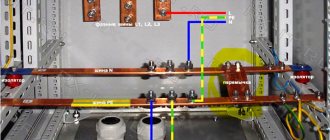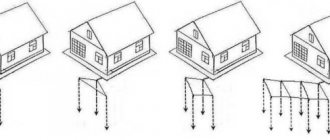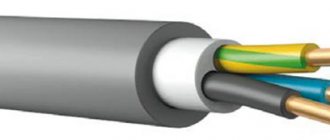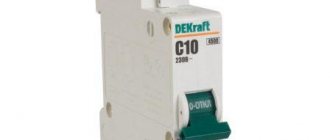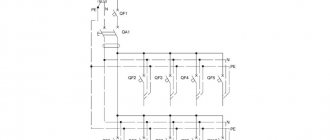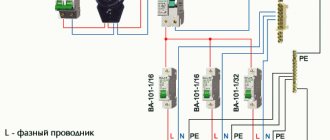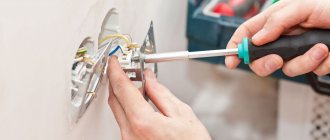Laying wires and accessories
First of all, the panel and RCD are installed, the number of which corresponds to the number of connection groups. A piece of wire with a cross section of 5 mm² is inserted inside the shield. Blue - attached to zero, white - to the top contact of the machine, grounding (yellow with a green stripe) - to ground. The RCDs are connected in series with a piece of white wire.
It is recommended to start installing new wiring in an apartment with your own hands from the farthest connection point.
The wire is cut into pieces of the required length with allowance for connections, pulled into corrugations on the floor and then laid in grooves.
To connect sockets, a wire with a cross-section of 2.5 mm² is used, for lighting fixtures and switches - a wire of 1.5 mm². It is advisable to attach a tag to the end of each wire indicating the purpose and location of the connection group (point).
Wires in junction boxes are connected using PPE or simply well insulated. The main wire inside the panel is connected as follows: the blue conductor - to the neutral bus, the phase conductor, in red or brown insulation - to the RCD below, the grounding wire - to the ground below.
After this, the wiring is called and, if the installation is done correctly, all that remains is to call an electrician to connect it to the distribution board. How to properly install and lay electrical wiring in an apartment with your own hands, you can watch further in the video:
https://youtube.com/watch?v=srxk7BEr0KM
All work is performed only with working tools; the handles of hand tools must be insulated. For additional protection, rubberized gloves are required; wall-shaping work is performed with safety glasses and a respirator. Grooving at height is done from a trestle or from a stepladder with a side support.
In this video, an experienced specialist will tell and show how to change the electrical wiring in an apartment with your own hands:
Determine what kind of electrical wiring you have now
Important! Before describing the work, I must warn that any work related to electricity should be carried out only when the power supply to the apartment is turned off. So where to start
Of course, from the beginning, namely from the place where the power supply to the apartment comes from. Depending on the type of house, this may be a floor distribution board or a separate one, an apartment panel or a symbiosis of floor and apartment panels
So where to start. Of course, from the beginning, namely from the place where the power supply to the apartment comes from. Depending on the type of house, this may be a floor switchboard or a separate one, an apartment switchboard or a symbiosis of floor and apartment switchboards.
To begin with, let’s open the floor panel and find the circuit breakers that are “responsible” for your apartment. There must be one device that turns off all power to the apartment. This is an introductory device. It could be a circuit breaker, then it is located on the left in the row of your machines, or a switch, then it is located separately at the top or bottom, although there may be options.
Photos of old floor boards
You will not be able to replace the input device yourself, since you need to turn off the power supply to the entire (or part) of the entrance, and this can only be done by an employee of the operating organization. But you can see the nominal value of the introductory machine. Watch and record.
Let's move on. Let's see how many circuit breakers are installed for your apartment. There should be at least two of them. Three with electric stove. One machine is lighting. Second automatic socket. The third automatic electric stove. If you have more machines, then you need to determine which machines are turned off.
Note. The circuit breaker is designed to protect electrical wiring from overvoltage, short circuit and simple communication (turning on and off the power supply).
To determine which machines are being turned off, turn on the lights in the apartment, plug in the lighting fixtures into the sockets and simply turn off the circuit breakers and see what will turn off in the apartment when the machines are turned off sequentially. Do not use complex household appliances for such diagnostics to avoid their damage if the machine is abruptly turned off.
Let's analyze the situation and determine what to do next. So, after such a simple diagnosis, you have a diagram of your old electrical wiring.
It may well look like this:
We will determine the stages of electrical wiring repair.
Marking and gating of walls
To mark, you will need a level, tape measure, chalk or construction pencil. In the places where the sockets are installed, 7x7 cm squares are drawn; if a double socket is to be installed, a rectangle 14 cm wide is drawn on the markings. Then cable routing routes are drawn on the wall in accordance with the plan.
Lastly, mark the location of the switches, marking them with squares, just like the sockets. 9x20 cm rectangles are drawn for distribution boxes.
The holes for sockets and switches are marked with a core drill, then grooves are cut along the marked lines with a grinder.
The depth of the groove is at least 20 mm; the width of the groove depends on the number of wires that must be laid in a particular area. All wires must fit completely freely.
After cutting the grooves, all that remains is to knock out the grooves and all the intended holes. Grilling is a labor-intensive, dirty and noisy process; work should be planned during working hours and neighbors should be notified in advance.
Where to begin
Initially, it is necessary to resolve organizational issues. In order to replace the electricity input, you will need to open the sealed meter. Since the homeowner is strictly prohibited from doing this on his own, coordination with the organization involved in the control and supply of electricity will be required. As a rule, this is done by the relevant departments of district or municipal electrical networks.
At the first stage, you need to determine the scope of related work for the planned installation. The degree of complexity and labor involved will largely depend on the material of the walls of the house, how the old line was laid, the distance from the access panel to the wall of the apartment, as well as the decision to what extent the work will be done, with or without replacing the meter.
When deciding whether to do the work yourself, you should remember that this type of installation requires a professional solution to the issue by an experienced electrician who knows and complies with the requirements of regulatory documents. To attract specialists, it is better not to try to solve the painful question of who to call as an electrician, but to contact a management company or another organization involved in the operation of electrical equipment at home.
Features of replacing cable glands in the house
In most cases, the power supply to a private home is carried out via a tap from an overhead power line, for which a self-supporting insulated wire with aluminum conductors of the SIP grade is used. It is possible that part of the entrance highway will be laid along the façade of the building. Replacing part of the input from the pillar to the wall does not cause any special problems; it can be easily done by specialists
It is very important to install wiring along the wall of the house in accordance with the requirements of electrical fire safety standards, as well as to correctly enter into the wall. If the facade is made of non-combustible materials and is not finished with siding, the input cable can be laid in a box or corrugated pipe. The owner of a private house needs to know that the SIP has a flammable sheath, and therefore it is prohibited to lay such wiring on wood, therefore, before attaching the line to a wooden wall, it is necessary to connect to a cable with copper conductors using special sealed clamps
In the case of siding trim, the SIP, even if it is laid in a protective shell, must be at least 7 cm away from the wall. The entrance to the building through a wooden wall is equipped with a metal sleeve, which is used as a thick-walled pipe. We talked in more detail about how to run a cable through a wall in a separate article.
A special issue is replacing the input cable in a wooden house, as it requires strict compliance with fire safety standards. In this case, it is better to use a metal hose or a metal cable channel for installation; you can use a pipe
It is important to remember that only cable products with a three-layer non-flammable sheath are allowed to work. Of the domestic products, the VVGng-p brand is best suited
The entrance to a wooden wall should be equipped with a metal cup, wrapped in asbestos and fixed with an alabaster mixture. Placing the cable in metal protective equipment is possible only if there is a grounding loop, since they will require mandatory grounding.
Electrical panel installation - step-by-step DIY assembly guide
Correct cable entry greatly simplifies installation and allows for optimal organization of the internal space. You should buy shields that have technological holes for entry, otherwise you will have to cut or drill them. Good shields have plugs that we remove and install the cable. We connect it to the input machine and secure it with a plastic clamp. We mark all cables at once.
The residual current device contains a differential transformer that compares the balance of incoming and outgoing current. If it is broken, which happens when there is an uncontrolled leakage of current or when a person comes under voltage, the protection is triggered. The network with the RCD turns off, and the person does not even have time to feel the electric shock. The protective shutdown is designed for a current that is safe for humans.
Determining the complexity of the work
So, first you must analyze the old wiring and find out the following points:
Is there a grounding system at the site? This is very important, because without a grounding loop you can suffer if household appliances fail or insulation breaks down. Is it possible to partially change the wiring in a private house or is it necessary to completely replace the electrical system?
Perhaps some rooms have recently been renovated and, accordingly, a new, more powerful cable has been installed that will meet modern requirements. Will you be able to carry out the electrical installation yourself or will you have to hire a specialist for this? It should be noted that replacing the electrical wiring in the house with your own hands is not difficult, but the undertaking is labor-intensive and requires special care. If you don’t doubt your abilities, of course, do everything yourself
Otherwise, first find out the cost of the master’s work, because... To do this you will have to pay a considerable amount of money.
Having collected all the necessary information about the complexity and scope of work, you can get down to business. The video explains in detail whether it is worth completely replacing the old wiring with a new one:
Pros and cons of completely replacing electrical wiring
When to change wiring
Of course, new wiring will be required in a newly completed apartment, but buying a new home is not the only reason when you should think about changing the wiring.
It is also worth paying attention to how electrical appliances are connected today in an existing apartment, in which the electrical network was located in accordance with established GOSTs. After all, then there was no expectation that very soon there would be so many electrical appliances that would be constantly in use, and they would constantly not have enough sockets
Because of this deficiency, extension cords and new lines begin to appear in the house on top of the walls, which is not only aesthetically unpleasant, but can also be dangerous if you connect a lot of equipment at once. This is especially true for those situations where tees or even several tees at once are used, connecting to each other and to one unfortunate outlet. Such piles are a direct road to short circuit and fire.
*(The appearance of a similar picture in the house is a clear hint that it’s time to change the wiring).
Or another problem may arise - aluminum wires. Such, for the sake of economy, were often used in the construction of high-rise buildings, when there was a special boom in their construction several years ago. Aluminum conducts electricity well, but it has a couple of serious disadvantages:
- Aluminum is too soft. That is, it is very easy to deform under external influence, and it can even break completely. And for the same reasons, repairs are not easy to carry out, since it will not be possible to properly change only a section.
- Chemical reactions. When current constantly passes through aluminum, it provokes electrochemical reactions in the wires, which increase their fragility. And after 15–20 years, which is a very short period of time for electrical wiring, the wires can become so fragile that sudden breaks begin to appear in them. And if you try to repair the wire and make new twists, nothing will work - the wires will break in your hands.
- Corrosion. Aluminum is not as resistant to moisture as we would like, and then even a small amount of water will lead to electrocorrosion. And even if the wires look intact on the outside, they may already be so damaged on the inside that even a small load will cause them to break or spark.
*(To ensure wiring lasts as long as possible, it is better to choose copper rather than aluminum)
To sum up the issue with aluminum: if the wiring is made of this metal, it is better to completely replace it with copper, which is much more reliable. Of course, copper, due to its properties, is more expensive. However, wiring is not done annually, but once every few decades, so there is no need to save money here.
Reasons for replacing the wire
Most people living in the private sector are concerned about why and how to replace the cable from the pole to the house. The supply of electricity to cottages, country houses, and private houses is usually carried out from overhead main lines. Electric poles carry bare wires secured through support insulators. Most of the main lines are long outdated, in a dangerous situation, and also heavily overloaded, because electricity consumption increases every year.
Often in bad weather, due to strong winds, wires break or a short circuit occurs. Organizations whose responsibilities include servicing main lines usually do not immediately come to the scene of an accident, and when they arrive, they generally perform their work poorly. Therefore, the next time unfavorable weather occurs, everything repeats again.
How to connect electricity from a pole to a house
Work on connecting the cable from the power line pole to the input distribution box at the house should be carried out by a specialized organization: this is too sensitive an area. However, you need to decide on the input method - overhead or underground - as well as the type of cable and its cross-section. So you will have to figure out how you can connect electricity from the pole to the house and choose your option.
Electrical supply by air
The air supply method is attractive because it does not require a lot of time and money. But the standards set requirements that not all houses meet:
- The cable entry into the house must be located at a height of at least 2.75 m. If the height of the house is sufficient, a distribution panel with an RCD is mounted on the wall, and the cable from the pole is connected to it. If the house has a smaller height, a special rack (pipe rack) is installed. It can be of a curved shape called a “gander” (in the picture on the left) or straight (in the picture on the right). These two input methods differ in the method of fastening to the walls of the house (see photo). Methods of installing a rack for air supply of electricity into the house
- The distance from the pole to the entry point should not exceed 10 m. If this distance is greater, additional support is installed. The distance from it to the power line should not be more than 15 m.
- The tap from the power line is made: up to 10 m - with copper wire with a cross-section of 4 mm;
- from 10 to 15 m - with a wire with copper conductors with a cross-section of 6 mm.
- aluminum wires are used in any case with a diameter of at least 16 mm.
Connecting to a power pole by air
Although copper wires require a smaller diameter, they cost significantly more than aluminum wires. Therefore, the introduction of electricity into the house from a pole is most often made from cables with aluminum conductors. There are two ways:
- Stretch a torso or wire between the posts and attach a current-carrying cable to it with special clamps.
- Use self-supporting wires for which support is not needed: SIP (self-supporting insulated wire). It is connected using:
- insulators (glass, polymer, porcelain);
- special fittings.
Reasons for replacement
There may be several reasons. Firstly, due to the failure of the input line or the need for replacement is dictated by the service life of the cable. Secondly, the home of a modern person is equipped with an extensive fleet of electrical appliances, the operation of which creates a significant current load that exceeds the calculated power value for which the cross-section of the existing input main is designed. Thirdly, the desire to equip a personal apartment switchboard. It is no secret that entrance panels, for example, in an old panel house are equipped, at best, with only one electrical circuit breaker, which provides power supply and protection for the entire apartment. At the same time, not everywhere has yet managed to get rid of such a heavy legacy of the past as plug fuses.
The realities of our time suggest dividing the residential power supply system into several groups, connected to separate circuit breakers, as well as the need to connect modern means of protection against surge voltages, RCDs, differential circuit breakers that guarantee trouble-free operation of household electrical appliances and electrical fire safety of housing. Before installing and connecting an apartment switchboard equipped in accordance with the latest requirements, it is advisable to change the input cable to a more powerful one, the service life of which will begin from scratch. In addition, you need to correctly select the cross-section of current-carrying conductors corresponding to the planned total load of consumers. Next we will talk in detail about how to replace the input cable in an apartment or private house.
